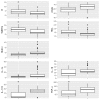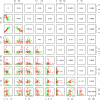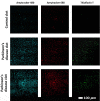Parkinson's Disease: A Systemic Inflammatory Disease Accompanied by Bacterial Inflammagens
- PMID: 31507404
- PMCID: PMC6718721
- DOI: 10.3389/fnagi.2019.00210
Parkinson's Disease: A Systemic Inflammatory Disease Accompanied by Bacterial Inflammagens
Abstract
Parkinson's disease (PD) is a well-known neurodegenerative disease with a strong association established with systemic inflammation. Recently, the role of the gingipain protease group from Porphyromonas gingivalis was implicated in Alzheimer's disease and here we present evidence, using a fluorescent antibody to detect gingipain R1 (RgpA), of its presence in a PD population. To further elucidate the action of this gingipain, as well as the action of the lipopolysaccharide (LPS) from P. gingivalis, low concentrations of recombinant RgpA and LPS were added to purified fluorescent fibrinogen. We also substantiate previous findings regarding PD by emphasizing the presence of systemic inflammation via multiplex cytokine analysis, and demonstrate hypercoagulation using thromboelastography (TEG), confocal and electron microscopy. Biomarker analysis confirmed significantly increased levels of circulating proinflammatory cytokines. In our PD and control blood analysis, our results show increased hypercoagulation, the presence of amyloid formation in plasma, and profound ultrastructural changes to platelets. Our laboratory analysis of purified fibrinogen with added RgpA, and/or LPS, showed preliminary data with regards to the actions of the protease and the bacterial membrane inflammagen on plasma proteins, to better understand the nature of established PD.
Keywords: LPS from Porphyromonas gingivalis; Parkinson’s disease; amyloid formation; cytokines; gingipains; systemic inflammation.
Figures








References
-
- Ally N., Whisstock J. C., Sieprawska-Lupa M., Potempa J., Le Bonniec B. F., Travis J., et al. (2003). Characterization of the specificity of arginine-specific gingipains from Porphyromonas gingivalis reveals active site differences between different forms of the enzymes. Biochemistry 42 11693–11700. 10.1021/bi0349726 - DOI - PubMed
-
- Ambrosio N., Marin M. J., Laguna E., Herrera D., Sanz M., Figuero E., et al. (2019). Detection and quantification of Porphyromonas gingivalis and Aggregatibacter actinomycetemcomitans in bacteremia induced by interdental brushing in periodontally healthy and periodontitis patients. Arch. Oral Biol. 98 213–219. 10.1016/j.archoralbio.2018.11.025 - DOI - PubMed
LinkOut - more resources
Full Text Sources
Other Literature Sources

